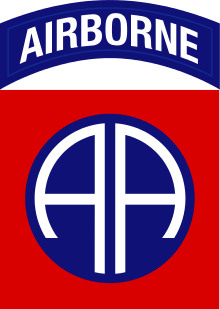82nd Airborne Division
| 82nd Division 82nd Infantry Division 82nd Airborne Division | |
|---|---|
|
Insignia of the 82nd Airborne Division | |
| Active |
1917–1919 1921–present |
| Country |
|
| Branch |
|
| Type | Airborne infantry |
| Role | Command and control organization containing two to four maneuver brigades |
| Size | Division |
| Part of | XVIII Airborne Corps |
| Garrison/HQ | Fort Bragg, North Carolina, U.S. |
| Nickname(s) | "All American Division", "82nd Division", "82nd Infantry Division", "America's Guard of Honor", "The 82nd", within the unit and the wider airborne community simply |
| Motto(s) | "All the way!" "Death from above" |
| March | "The All-American Soldier" |
| Engagements |
|
| Website | https://www.bragg.army.mil/index.php/units-tenants/82nd-airborne-division |
| Commanders | |
| Commander | MG Erik Kurilla |
| Deputy Commander – Operations | COL Matt McFarlane |
| Deputy Commander – Support | COL Michael Fenzel |
| Deputy Commander – Interoperability | Brigadier (UK) James Learmont |
| Command Sergeant Major | Command Sergeant Major Michael Green |
| Notable commanders | Complete list of commanders |
| Insignia | |
| Combat service identification badge |
 |
| Shoulder sleeve insignia (UCP ACU) |
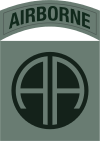 |
| Flag |
 |
The 82nd Airborne Division is an airborne infantry division of the United States Army, specializing in parachute assault operations into denied areas. Based at Fort Bragg, North Carolina, the 82nd Airborne Division is part of the XVIII Airborne Corps. The 82nd Airborne Division is the U.S. Army's most strategically mobile formation.[1] The 82nd Airborne Division is one of the most highly trained light infantry divisions in the world.
The division was constituted, originally as the 82nd Division, in the National Army on 5 August 1917, shortly after the American entry into World War I, and was organized on 25 August 1917, at Camp Gordon, Georgia and later served with distinction on the Western Front in the final months of World War I. Since its initial members came from all 48 states, the unit acquired the nickname All-American, which is the basis for its famed "AA" shoulder patch. The division later served in World War II where, in August 1942, it was reconstituted as the first airborne division of the U.S. Army and fought in numerous campaigns during the war, gaining an excellent reputation.
Famous soldiers of the division include Sergeant Alvin C. York, General James M. Gavin, General of the Army Omar Bradley, Senator Strom Thurmond (325th Glider Infantry Regiment in World War II), Senator Jack Reed, R&B singer Lou Rawls, actor William Windom, country music singer Craig Morgan, former Syracuse University football coach Ben Schwartzwalder, fashion critic/choreographer Bruce Darnell, The Honorable Patrick Murphy (Under Secretary of the Army), Louisiana Governor John Bel Edwards, and General "Henry" Hugh Shelton (Chairman of the Joint Chiefs of Staff from 1997 to 2001).
Origins
The 82nd Division was first constituted on 5 August 1917 during World War I in the National Army. It was organized and formally activated on 25 August 1917 at Camp Gordon, Georgia.[2] The division consisted entirely of newly conscripted soldiers.[3] The citizens of Atlanta held a contest to give a nickname to the new division. Major General Eben Swift, the commanding general, chose "All American" to reflect the unique composition of the 82nd—it had soldiers from all 48 states.[4] The bulk of the division was two infantry brigades, each commanding two regiments. The 163rd Infantry Brigade commanded the 325th Infantry Regiment and the 326th Infantry Regiment. The 164th Infantry Brigade commanded the 327th Infantry Regiment and the 328th Infantry Regiment.[5] Also in the division were the 157th Field Artillery Brigade, composed of the 319th, 320th and 321st Field Artillery Regiments and the 307th Trench Mortar Battery; a divisional troops contingent, and a division train. It sailed to Europe to join the American Expeditionary Force (AEF), commanded by General John Pershing, on the Western Front.[6]
World War I
William P. Burnham, who had previously commanded the 164th Brigade, led the division during most of its training and its movement to Europe. In early April, the division embarked from the ports in Boston, New York and Brooklyn to Liverpool, England, where the division fully assembled by mid-May 1918.[7] From there, the division moved to mainland Europe, leaving Southampton and arriving at Le Havre, France,[7] and then moved to the British-held region of Somme on the front lines, where it began sending small numbers of troops and officers to the front lines to gain combat experience. On 16 June it moved by rail to Toul, France to take position on the front lines in the French sector. Its soldiers were issued French weapons and equipment to simplify resupply.[3] The division was briefly assigned to I Corps before falling under the command of IV Corps until late August. It was then moved to the Woëvre front, in the Lagney sector, where it operated with the French 154th Infantry Division.[7]
St. Mihiel
The division relieved the 26th Division on 25 June. Though Lagney was considered a defensive sector, the 82nd Division actively patrolled and raided in the region for several weeks, before being relieved by the 89th Division.[3] From there it moved to the Marbache sector in mid-August, where it relieved the 2nd Division under the command of the newly formed US First Army.[7] There it trained until 12 September, when the division joined the St. Mihiel offensive.[3]
Once the First Army jumped off on the offensive, the 82nd Division engaged in a holding mission to prevent German forces from attacking the right flank of the First Army. On 13 September, the 163rd Infantry Brigade and 327th Infantry Regiment raided and patrolled to the northeast of Port-sur-Seille, toward Eply, in the Bois de Cheminot, Bois de la Voivrotte, Bois de la Tête-d'Or, and Bois Fréhaut. Meanwhile, the 328th Infantry Regiment, in connection with the attack of the 90th Division against the Bois-le-Prêtre, advanced on the west of the Moselle River, and, in contact with the 90th Division, entered Norroy, advancing to the heights just north of that town where it consolidated its position. On 15 September, the 328th Infantry, in order to protect the 90th Division's flank, resumed the advance, and reached Vandières, but withdrew on the following day to the high ground north of Norroy.[7]
On 17 September, the St-Mihiel Operation stabilized, and the 90th Division relieved the 82nd's troops west of the Moselle River. On 20 September, the 82nd was relieved by the French 69th Infantry Division, and moved to the vicinity of Marbache and Belleville, then to stations near Triaucourt and Rarécourt in the area of the First Army.[7] During this operation, the division suffered heavy casualties from enemy artillery. The operation cost the division over 800 men. Among them was Colonel Emory Pike, the first member of the 82nd to be awarded the Medal of Honor.[3] The division was then moved into reserve until 3 October, when it assembled near Varennes-en-Argonne prior to returning to the line.[7] During this time, the division trained and prepared for the war's final major offensive at Meuse-Argonne.[3]
Meuse-Argonne

The division was next moved to the Clermont area, located west of Verdun on September 24. They were stationed there to act as a reserve for the US First Army.[8] George B. Duncan, former commander of the 77th Division, relieved Burnham on 3 October, and Burnham subsequently served as military attaché in Athens, Greece. On the night of 6/7 October 1918, the 164th Infantry Brigade relieved troops of the 28th Division, which were holding the front line from south of Fléville to La Forge, along the eastern bank of the Aire River. The 163rd Infantry Brigade remained in reserve. On 7 October, the division, minus the 163rd Infantry Brigade, attacked the northeastern edge of the Argonne Forest, making some progress toward Cornay, and occupied Hill 180 and Hill 223. The next day it resumed the attack. Elements of the division's right flank entered Cornay, but later withdrew to the east and south. The division's left flank reached the southeastern slope of the high ground northwest of Châtel-Chéhéry. On 9 October, the division continued its attack, and advanced its left flank to a line from south of Pylône to the Rau de la Louvière.[7]
For the rest of the month, the division turned to the north and advanced astride the Aire River to the region east of St-Juvin. On 10 October, it relieved troops of the 1st on the right, north of Fléville, as far as a new boundary extending north and south through Sommerance. It then attacked and captured Cornay and Marcq, and established the front just to their south. On 11 October, the right flank of the division occupied Sommerance and the high ground north of la Rance Rau while the left advanced to the railroad south of the Aire. The next day, the 42nd relieved the 82nd's troops in and near Sommerance, allowing it to resume the attack. The 82nd passed through part of the Hindenburg defensive position, and reached a line just north of the road from St-Georges to St-Juvin.[7]
On 18 October, the division relieved elements of the 78th as far to the left as Marcq and Champigneulle. Three days later it advanced to the Ravin aux Pierres. On 31 October, the 82nd, except the artillery, was relieved by the 77th Division and the 80th Division, and assembled in the Argonne Forest near Champ-Mahaut. On 2 November, the division concentrated near La Chalade and Les Islettes, and, on 4 November, moved to training areas in Vaucouleurs. On 10 November, it moved again to training areas in Bourmont, where it remained until the 11 November armistice.[7] During this campaign the division suffered another 7,000 killed and wounded. A second 82nd soldier, Alvin C. York, won the Medal of Honor during this campaign.[3]
Post-war
The division suffered 995 killed and 7,082 wounded, for a total of 8,077 casualties.[9] Following the war's end, the division moved to training areas near Prauthoy, where it remained through February 1919.[7] It returned to the United States in April and May, and was demobilized and deactivated at Camp Mills, New York on 27 May.[2]
For the next 20 years the 82nd Division existed only as a unit of the Organized Reserve.[10] It was reconstituted on 24 June 1921 establishing headquarters at Columbia, South Carolina, in January 1922. The 82nd formed part of the Organized Reserves, and elements of the division were located in South Carolina, Georgia, and Florida.[3]
World War II
Louisiana to Italy
The 82nd Division was redesignated on 13 February 1942 during World War II as Division Headquarters, 82nd Division. It was recalled to active service on 25 March 1942, and reorganized at Camp Claiborne, Louisiana, under the command of Major General Omar Bradley. During this training period, the division brought together four officers who would ultimately steer the U.S. Army during the following two decades: Matthew Ridgway, Matthew D. Query, James M. Gavin, and Maxwell D. Taylor.[11] Under Major General Bradley, the 82nd Division's Chief of Staff was George Van Pope.[12]

On 15 August 1942, the 82nd Infantry Division, now commanded by Major General Ridgway, became the first airborne division of the U.S. Army, and was redesignated as the 82nd Airborne Division. The division initially consisted of the 325th, 326th and 327th Infantry Regiments. The 327th was soon transferred to help form the 101st Airborne Division and replaced by the 504th Parachute Infantry Regiment, leaving the division with two regiments of glider infantry and one of parachute infantry. In early 1943 the division received another change when the 326th was later transferred, being replaced by the 505th Parachute Infantry Regiment, under James M. Gavin, then a colonel, who was later destined to command the 82nd.
In April 1943, after several months of tough training, its troopers deployed to the Mediterranean Theater of Operations, under the command of Major General Ridgway to take part in the campaign to invade Sicily. The division's first two combat operations were parachute assaults into Sicily on 9 July and Salerno on 13 September 1943. The initial assault on Sicily, by the 505th Parachute Regimental Combat Team, under Colonel Gavin, was the first regimental-sized combat parachute assault conducted by the United States Army. The first glider assault did not occur until Operation Neptune as part of the D-Day landings of June 6, 1944. Glider troopers of the 319th and 320th Glider Field Artillery Battalions and the 325th Glider Infantry Regiment (and the 3rd Battalion of the 504th PIR) instead arrived in Italy by landing craft at Maiori (319th) and Salerno (320th, 325th).
In January 1944, the 504th Parachute Infantry Regiment, commanded by Colonel Reuben Tucker, which was temporarily detached to fight at Anzio, adopted the nickname "Devils in Baggy Pants", taken from an entry in a German officer's diary. The 504th was replaced in the division by the inexperienced 507th Parachute Infantry Regiment, under the command of Colonel George V. Millet, Jr.. While the 504th was detached, the remainder of the 82nd Airborne Division moved to the United Kingdom in November 1943 to prepare for the liberation of Europe. See RAF North Witham and RAF Folkingham.
Normandy
With two combat drops under its belt, the 82nd Airborne Division was now ready for the most ambitious airborne operation of the war so far, as part of Operation Neptune, the invasion of Normandy. The division conducted Operation Boston, part of the airborne assault phase of the Operation Overlord plan.
In preparation for the operation, the division was reorganized. To ease the integration of replacement troops, rest, and refitting following the fighting in Italy, the 504th PIR did not rejoin the division for the invasion. Two new parachute infantry regiments (PIRs), the 507th and the 508th, provided it, along with the 505th, a three-parachute infantry regiment punch. On 5 and 6 June, these paratroopers, parachute artillery elements, and the 319th and 320th, boarded hundreds of transport planes and gliders to begin history's largest airborne assault at the time (only Operation Market Garden later that year would be larger). During the June 6th assault, a 508th platoon leader, Lieutenant Robert P. Mathias, would be the first U.S. Army officer killed by German fire on D-Day [13] On June 7, after this first wave of attack, the 325th Glider Infantry Regiment would arrive by glider to provide a division reserve.
In Normandy, the division saw 33 days of combat. Losses included 5,245 troopers killed, wounded, or missing. Ridgway's post-battle report stated in part, "... 33 days of action without relief, without replacements. Every mission accomplished. No ground gained was ever relinquished."[10]
Following Normandy, the 82nd Airborne became part of the newly organized XVIII Airborne Corps, which consisted of the U.S. 17th, 82nd, and 101st Airborne Divisions. Ridgway was given corps command, but was not promoted to lieutenant general until 1945. His recommendation for succession as division commander was Brigadier General James M. Gavin. Ridgway's recommendation met with approval, and upon promotion Gavin became the youngest general since the Civil War to command a U.S. Army division.[14]
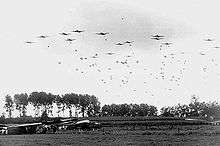
Market Garden
On 2 August 1944 the division became part of the First Allied Airborne Army. In September, the 82nd began planning for Operation Market Garden in the Netherlands. The operation called for three-plus airborne divisions to seize and hold key bridges and roads deep behind German lines. The 504th PIR, now back at full strength, was reassigned to the 82nd, while the 507th was assigned to the 17th Airborne Division, at the time training in England. On 17 September, the 82nd conducted its fourth combat jump of World War II. Fighting off German counterattacks, the 82nd captured its objectives between Grave, and Nijmegen. However, the failure of the British 1st Airborne Division to seize the Arnhem bridge allowed the Germans to move defenders to the Nijmegen bridge. The division failed to capture Nijmegen Bridge when the opportunity presented itself early in the battle. When the British XXX Corps arrived in Nijmegen, 6 hours ahead of schedule, they found themselves having to fight to take a bridge that should have already been in allied hands. In the afternoon of Wednesday 20 September 1944 the 82nd Airborne conducted a successful opposed river assault on the river crossing of the Waal river, capturing the north end of the Nijmegen road bridge. War correspondent Bill Downs, who witnessed the assault, described it as "a single, isolated battle that ranks in magnificence and courage with Guam, Tarawa, Omaha Beach. A story that should be told to the blowing of bugles and the beating of drums for the men whose bravery made the capture of this crossing over the Waal possible."[15]
British XXX Corps units did not follow up their own and the 82nd's success by advancing toward Arnhem. This led to some friction between the 82nd's Colonel Tucker and Major General Gavin and Lord Carrington of the British Army. By the time the advance was resumed the opportunity for a rapid capture of the road to Arnhem had passed. So the costly successes of the 82nd's Nijmegen bridge seizure was followed by the failure to take the main prize; the British 1st Airborne Division was lost at the Battle of Arnhem. The Market-Garden salient was held in a defensive operation for several weeks until the 82nd was relieved by Canadian troops, and sent into reserve in France.
The Bulge

On 16 December 1944, the Germans launched a surprise offensive through the Ardennes Forest, which became known as the Battle of the Bulge. In SHAEF reserve, the 82nd was committed on the northern face of the bulge near Elsenborn Ridge.
On 20 December 1944, the 82nd Airborne Division was assigned to take Cheneux where they would force the Waffen SS Division Leibstandarte's Kampfgruppe Peiper into a fighting retreat. On 21–22 December 1944, the 82nd Airborne faced counterattacks from three powerful Waffen SS divisions which included the 1st SS Panzer Division Leibstandarte SS Adolf Hitler, 2nd SS Panzer Division Das Reich, and the 9th SS Panzer Division Hohenstaufen. Their efforts to relieve Kampfgruppe Peiper failed.[16]
On December 23 it attacked from the south and overran the 325th GIR holding the Baraque- Fraiture crossroads on the 82nd’s southern flank, endangering the entire 82nd Airborne division. The 2nd SS Panzer’s objective was to outflank the 82nd Airborne. It was not an attack designed to reach Peiper, but it was his last chance, nonetheless. If it did outflank the 82nd, it could have opened a corridor and reached the stranded yet still powerful Kampfgruppe. But the attack came too late.
On 24 December 1944, the 82nd Airborne Division with an official strength of 8,520 men was facing off against a vastly superior combined force of 43,000 men and over 1,200 armored fighting and artillery vehicles and pieces.[17] Due to these circumstances the 82nd Airborne Division was forced to withdrawal for the 1st time in its combat history.[18] The German’s pursued their retreat with the 2nd and 9th SS Panzer Divisions. The 2nd SS Panzer Division Das Reich engaged the 82nd until 28 December when it and what was left of the 1st SS Panzer Division Leibstandarte were ordered to move south to meet General Patton’s forces attacking in the area of Bastogne.[19] Some units of the 9th SS Panzer including the 19th Panzer Grenadier Regiment stayed and fought the 82nd. They were joined by the 62nd Volksgrenadier Division. The 9th SS Panzer tried to breakthrough by attacking the 508 and 504 PIR positions, but ultimately failed.[20] The failure of the 9th and 2nd SS Panzer Divisions to break through the 82nd lines marked the end of the German offensive in the northern shoulder of the Bulge. The German objective now became one of defense.
On 3 January 1945, the 82nd Airborne Division conducted a counterattack. On the first day’s fighting the Division overran the 62nd Volksgrenadiers and the 9th SS Panzer’s positions capturing 2,400 prisoners.[21] The 82nd Airborne suffered high casualties in the process. The attached 551st Parachute Infantry Battalion was all but decimated during these attacks. Of the 826 men that went into the Ardennes, only 110 came out. Having lost its charismatic leader Lt. Colonel Joerg, and almost all its men either wounded, killed, or frostbitten, the 551 was never reconstituted. The few soldiers that remained were later absorbed into units of the 82nd Airborne.[22]
After several days of fighting the destruction of the 62nd Volksgrenadiers and what had been left of the 9th SS Panzer Division was complete. For the 82nd Airborne Division the first part of the Battle of the Bulge had ended.[23]
Into Germany
After helping to secure the Ruhr, the division ended the war at Ludwigslust past the Elbe River, accepting the surrender of over 150,000 of Lieutenant General Kurt von Tippelskirch's 21st Army. General Omar Bradley, commanding the U.S. 12th Army Group, stated in a 1975 interview with Gavin that Bernard Montgomery, Commander of the Anglo-Canadian 21st Army Group, had told him German opposition was too great to cross the Elbe. When Gavin's division crossed the river, in company with the British 6th Airborne, the division moved 36 miles in one day and captured over 100,000 troops, causing great laughter in Bradley's 12th Army Group headquarters.[24]
Following Germany's surrender, the 82nd entered Berlin for occupation duty, lasting from April until December 1945. In Berlin General George S. Patton was so impressed with the 82nd's honor guard he said, "In all my years in the Army and all the honor guards I have ever seen, the 82nd's honor guard is undoubtedly the best." Hence the "All-American" became also known as "America's Guard of Honor".[25] The war ended before their scheduled participation in the invasion of Japan. During the invasion of Italy, Ridgway considered Will Lang Jr. of TIME magazine an honorary member of the division.
Casualties
- Total battle casualties: 9,073[26]
- Killed in action: 1,619[26]
- Wounded in action: 6,560[26]
- Missing in action: 279[26]
- Prisoner of war: 615[26]
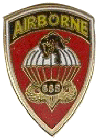
Cold War
Post–World War II
The division returned to the United States on 3 January 1946 on the RMS Queen Mary. In New York City it led a big Victory Parade, 12 January 1946. In 1947 the 555th Parachute Infantry Battalion was assigned to the 82nd and was reflagged as the 3rd Battalion, 505th Parachute Infantry Regiment. Instead of being demobilized, the 82nd found a permanent home at Fort Bragg, North Carolina, designated a Regular Army division on 15 November 1948. The 82nd was not sent to the Korean War, as both Presidents Truman and Eisenhower chose to keep it in strategic reserve in the event of a Soviet ground attack anywhere in the world. Life in the 82nd during the 1950s and 1960s consisted of intensive training exercises in all environments and locations, including Alaska, Panama, the Far East and the continental United States.
Pentomic organization
In 1957, the division implemented the pentomic organization (officially "Reorganization of the Airborne Division (ROTAD)) in order to better prepare for tactical nuclear war in Europe. Five battlegroups (each with a headquarters, headquarters and service company, 5 rifle companies and a mortar battery) replaced the division's 3 regiments of 3 battalions each. The division's five battlegroups were:[27]
- 1st Airborne Battlegroup (ABG), 504th Infantry (2nd ABG, 504th Infantry after 1958)(1)
- 2nd ABG, 501st Infantry
- 1st ABG, 325th Infantry
- 1st ABG, 505th Infantry (1st ABG, 187th Infantry after 1959)(1)
- 2nd ABG, 503rd Infantry (1st ABG, 503rd Infantry after 1960)(2)
- (1) 1st ABG, 504th Infantry and 1st ABG, 505th Infantry were re-assigned to the 8th Infantry Division in Germany to provide airborne capability in Germany
- (2) 2nd ABG, 503rd Infantry was re-assigned to the 25th Infantry Division and stationed in Okinawa to provide airborne capability in the Pacific
- the Division Artillery consisted of:
- Battery A, 319th Artillery
- Battery B, 319th Artillery
- Battery C, 319th Artillery (Battery C, 320th Artillery after 1960)
- Battery D, 320th Artillery
- Battery E, 320th Artillery
- Battery B, 377th Artillery
- additional division elements consisted of:
- 82nd Medical Company
- 82nd Signal Battalion
- 82nd Aviation Company
- Troop A, 17th Cavalry
- 307th Airborne Engineer Battalion
- 407th Supply and Transportation Company
- 782nd Maintenance Battalion
- 82nd Quartermaster Parachute Support Company
The pentomic organization was unsuccessful, and the division reorganized into 3 brigades of 3 battalions (the Reorganization Objective Army Division (ROAD) organization) in 1964.
Dominican Republic and Vietnam deployments
In April 1965, the "All-Americans" entered the civil war in the Dominican Republic, in which more than 3,000 Dominicans died. Spearheaded by the 3rd Brigade, the 82nd deployed in Operation Power Pack.
A year later, the 82nd went into action in Vietnam. During the Tet Offensive, which swept across the Vietnam in January 1968, the 3rd Brigade was en route to Chu Lai within 24 hours of receiving its orders. The 3rd Brigade performed combat duties in the Huế – Phu Bai area of the I Corps sector. Later the brigade moved south to Saigon, and fought in the Mekong Delta, the Iron Triangle and along the Cambodian border, serving nearly 22 months. While the 3rd Brigade was deployed, the division created a provisional 4th Brigade, consisting of 4th Battalion, 325th Infantry; 3rd Battalion, 504th Infantry; and 3rd Battalion, 505th Infantry. The Division Artillery also created an additional battalion, 3rd Battalion, 320th Artillery, to support the 4th Brigade.[27][28]
Within the United States, in 1967, the 82nd was sent to deal with the massive 1967 Detroit riot. Within two days of their deployment, the riots ended, with 43 people dead.
The units assigned and attached to the 3d Brigade of the 82nd Airborne Division were as follows:[29]
- Brigade Infantry:
- 1st Battalion, 505th Infantry Regiment (Airborne)
- 2d Battalion, 505th Infantry Regiment (Airborne)
- 1st Battalion, 508th Infantry Regiment (Airborne)
- Brigade Artillery:
- 2d Battalion, 321st Artillery (105mm)(Airborne)
- Brigade Aviation:
- A Company, 82d Aviation Battalion
- Brigade Reconnaissance:
- B Troop, 1st Squadron, 17th Cavalry (Armored)
- Company O, 75th Infantry Regiment (Ranger)
- Brigade Support:
- 82d Support Battalion
- 58th Signal Company
- C Company, 307th Engineer Battalion (Airborne)
- 408th Army Security Agency Detachment
- 52d Chemical Detachment
- 518th Military Intelligence Detachment
Post-Vietnam Operations
From 1969 into the 1970s, the 82nd deployed paratroopers to South Korea and Vietnam on more than 180DBT (Days Bad Time) for exercises in potential future battlegrounds. The division received three alerts. One was for Black September 1970. Paratroopers were on their way to Amman, Jordan when the mission was aborted. In May 1971 they were used to help national guard and Washington DC police to round up and arrest protestors.[30][31] Nine years later in August 1980, the 1st Battalion (Airborne), 504th PIR was alerted and deployed to conduct civil disturbance duty at Fort Indiantown Gap, Pennsylvania, during the Cuban refugee internment. War in the Middle East in the fall of 1973 brought the 82nd to full alert. In May 1978, the division was alerted to a possible drop into Zaire. In November 1979, the division was alerted for a possible operation to rescue the American hostages in Iran. The division formed the nucleus of the newly created Rapid Deployment Forces (RDF), a mobile force at a permanently high state of readiness.
Invasion of Grenada - Operation Urgent Fury
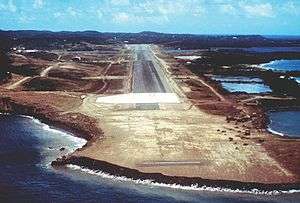
On 25 October 1983, elements of the 82nd conducted an Airland Operation to secure Point Salinas Airport following an airborne assault by the 1st and 2nd Ranger Battalions who conducted the airfield seizure just hours prior. The first 82nd unit to deploy was a task force of the 2nd and 3rd Battalions (Airborne), 325th Infantry. On 26 October and 27, the 1st Battalion (Airborne), 505th Infantry, and the 1st and 2nd Battalions (Airborne), 508th Infantry, deployed to Grenada with support units. 2-505 deployed as well. Military operations ended in early November (Note: that C/2-325 did not deploy due to being a newly formed COHORT unit, in its place A/2-504 deployed, landing at Point Salinas[32]). The 82d expanded its missions from the airhead at Salinas to weed out Cuban and Grenadian soldiers Each proceeding battalion pushed a single company forward with A/2-504 deploying only one company out of the entire brigade. The operation was flawed in several areas and identified areas needing attention to enhance the United States RDF doctrine. Newly issued Battle dress Uniforms (BDUs) were not designed for the tropical environment; communication between Army ground forces and Navy and Air Force aircraft lacked interoperability and even food and other logistic support to ground forces was hampered due to communication issues between the services. The operation proved the division's ability to act as a rapid deployment force. The first aircraft carrying troopers from the 2-325th touched down at Point Salines 17 hours after H-Hour notification.
In March 1988, a brigade task force made up of two battalions from the 504th Infantry and 3rd Battalion (Airborne), 505th Infantry, conducted a parachute insertion and air/land operation into Honduras as part of Operation Golden Pheasant. The deployment was billed as a joint training exercise, but the paratroopers were ready to fight. The deployment caused the Sandinistas to withdraw to Nicaragua. Operation Golden Pheasant prepared the paratroopers for future combat in an increasingly unstable world.
Panama: Operation Just Cause
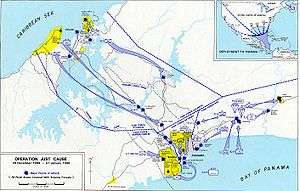
On 20 December 1989, the "All-American", as part of the United States invasion of Panama, conducted their first combat jump since World War II onto Torrijos International Airport, Panama. The goal of the 1st Brigade task force, which was made up of the 1-504 and 2-504 PIR as well as 4-325 AIR and Company A, 3-505 PIR, and 3-319th AFAR, was to oust Manuel Noriega from power. They were joined on the ground by 3-504 PIR, which was already in Panama. The invasion was initiated with a night combat jump and airfield seizures; the 82nd conducted follow-on combat air assault missions in Panama City and the surrounding areas of the Gatun Locks. The operation continued with an assault of multiple strategic installations, such as the Punta Paitilla Airport in Panama City and a Panamanian Defense Forces (PDF) garrison and airfield at Rio Hato, where Noriega also maintained a residence. The attack on La Comandancia (PDF HQ) touched off several fires, one of which destroyed most of the adjoining and heavily populated El Chorrillo neighborhood in downtown Panama City. The 82d Airborne Division secured several other key objectives such as Madden Dam, El Ranacer Prison, Gatun Locks, Gamboa and Fort Cimarron. Overall, the operation involved 27,684 U.S. troops and over 300 aircraft, including C-130 Hercules, AC-130 Spectre gunship, OA-37B Dragonfly observation and attack aircraft, C-141 and C-5 strategic transports, F-117A Nighthawk stealth aircraft and AH-64 Apache attack helicopters. The invasion of Panama was the first combat deployment for the AH-64, the HMMWV, and the F-117A. In the short six years since the Invasion of Grenada, Operation Just Cause demonstrated how quickly the US Armed Forces could adapt and overcome the mistakes and equipment interoperability issues to conduct a quick and decisive victory. In all, the 82d Airborne Division suffered 6 of the 23 fatalities of the operation. The paratroopers began redeployment to Fort Bragg on 12 January 1990. Operation Just Cause concluded on 31 Jan 1990, just 42 days (D+42) since the invasion started.
Post–Cold War
Persian Gulf War
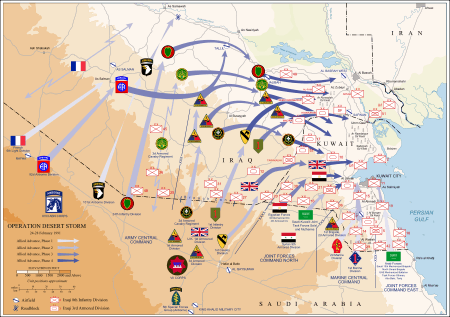

Seven months later the paratroopers of the 82nd Airborne Division were again called to war. Four days after the Iraqi invasion of Kuwait on 2 August 1990, 2/325th Airborne Infantry Regiment (AIR) was the Division Ready Force 1 (DRF-1) and the initial ground force,[33] as President George Bush's "Line in the Sand"[34] speech to Saddam Hussein part of the largest deployment of American troops since Vietnam as part of Operation Desert Shield. The 4-325th AIR immediately deployed to Riyadh, Saudi Arabia. Their role was to guard the royal family as part of the agreement with King Faud to station troops in the kingdom. The DRF 2 and 3 (1-325 and 2-325 AIR, respectively) began drawing the "line in the sand" near al Jubail by building defenses for possible retrograde operations. Soon after, the rest of the division followed. There, intensive training began in anticipation of desert fighting against the heavily armored Iraqi Army.
On 16 January 1991, Operation Desert Storm began when Allied war planes attacked Iraqi targets. As the air war began, 2d Brigade (325th AIR) of the 82nd initially deployed near an airfield in the vicinity of the ARAMCO oil facilities outside Abqaiq, Saudi Arabia. While 1st Brigade (504th PIR) and 3rd Brigade (505th PIR) consolidated at the Division HQ (CHAMPION Main) near Dhahran in Coinciding with the start of the air war, three National Guard Light-Medium Truck companies, the 253rd (NJARNG), 1122nd (AKARNG), and the 1058th (MAARNG) joined 2d Brigade of the 82d. In the coming weeks using primarily the 5-Ton cargo trucks of these NG truck companies, the 1st Brigade moved north to "tap line road" in the vicinity of Rafha, Saudi Arabia. Eventually, these National Guard truck units effectively "motorized" the 325th AIR, providing the troop ground transportation required for them to keep pace with the French Division Daguet during the incursion. The ground war began almost six weeks later. The 2/325th AIR was the division's spearhead for the ground war who actually took positions over the Iraqi border 24 hours in advance of coalition forces at 0800hrs on 22 February 1991 on Objectives Tin Man and Rochambeau. On 23 February, 82nd Airborne Division paratroopers protected the XVIII Airborne Corps flank as fast-moving armor and mechanized units moved deep inside south-western Iraq. After the second day, 1st Brigade moved forward to extend the Corps flank along with 3rd Brigade. In the short 100-hour ground war, the 82nd drove deep into Iraq and captured thousands of Iraqi soldiers and tons of equipment, weapons, and ammunition. During that time, the 82nd's band and MP company processed 2,721 prisoners. After the liberation of Kuwait and the surrender of the Iraqi Army, the 82nd redeployed to Fort Bragg between 18 March and 22 April after being deployed for a period of seven months.
Hurricane Andrew
In August 1992, the division deployed a task force to the hurricane-ravaged area of South Florida to provide humanitarian assistance following Hurricane Andrew. For more than 30 days, troopers provided food, shelter and medical attention to the Florida population as part of the U.S. military Domestic Emergency Planning System. The 82nd was part of over 20,000 Army, Navy, Air Force, Marine and an additional 6200 National Guard troops deployed for the disaster.[35]
They also provided security and a sense of safety for the victims of the storm who were without power, doors, windows and in many cases roofs. There were, as with all disasters, criminals trying to take advantage of the situation, in this case looters and thieves. The presence of the 82nd quickly eliminated that factor from the equation.[36]
Operation Restore Democracy: Haiti
On 16 September 1994, the 82d Airborne Division joined Operation Restore Democracy. The 82nd was scheduled to make combat parachute jumps into Pegasus Drop Zone and PAPIAP Drop Zone (Port-au-Prince Airport), in order to help oust the military dictatorship of Raoul Cédras, and to restore the democratically elected president, Jean-Bertrand Aristide. At the same time that former U.S. President Jimmy Carter and former Chairman of the Joint Chiefs of Staff Colin Powell were negotiating with Cédras to restore Aristide to power, the 82nd's first wave was in the air, with paratroopers waiting at Green Ramp to air land in Haïti once the airfields there had been seized. When the Haitian military verified from sources outside Pope Air Force Base that the 82nd was on the way, Cédras stepped down, averting the invasion.
Former Vice President Al Gore would later travel to Fort Bragg to personally thank the paratroopers of the 82nd for their actions, noting in a speech on 19 September 1994, that the 82nd's reputation was enough to change Cédras' mind:
But it did get a little close there for a while. As you may know, there were 61 planes in the air headed toward Haïti at the time they finally agreed. And at one point General Biamby came in and told General Cédras that he had just gotten word on his telephone that the airplanes had taken off from Pope Air Force Base, with soldiers from Fort Bragg, and that both disconcerted them and caused them to be suspicious of the intent of the negotiations, but it also created a situation where immediately after that, the key points they had been refusing to agree to were agreed to, a date certain, other matters that I won't go into in detail here.
Operations Safe Haven and Safe Passage
On December 12, 1994, the 2-505 Parachute Infantry Regiment with the 2nd Platoon of C-co, 307th Engineers, deployed as part of Operations Safe Haven and Safe Passage. The battalion deployed from Fort Bragg while on Division Ready Force 1 to restore order against thousands of Cuban refugees who had attacked and injured a number of Air Force personnel and one marine while protesting their detainment at Empire Range along the Panama Canal. The battalion participated in the safeguarding of the Cuban refugees, a camp cordon and reorganization, and the active patrolling in and around the refugee camps in and around the Panamanian jungle along the Panama canal for two months. General Engineering support in the area of camp establishment/improvement operations was provided by the Sappers of the habitually associated Task Force Panther Engineer platoon, 2/C-307th. (Task Force Panther was commanded by LTC Lloyd J. Austin III, who would later be the first African American General to command U.S. Central Command.) This support included the planning of camp power requirements, pouring of 78 concrete pads, 3 foot bridges, a set of "mock doors" for airborne pre-jump training, and a system of decks for the muddy camp. During the deployment, the paratroopers experienced a 92-degree Christmas Day and returned to Fort Bragg on February 14, 1995.
Operation Joint Endeavor: Bosnia
Battalions of the 82nd prepared for a possible parachute jump to support elements of the 1st Armored Division which had been ordered to Bosnia-Herzegovina as part of Operation Joint Endeavor. Only after engineers of the 1st Armored Division bridged the Sava River on 31 December 1995 without hostilities did the 82nd begin to draw down against plans for a possible airborne operation there. The 82d's 49th Public Affairs Detachment (Abn) was deployed in support of the 1st Armored Division and air-landed in Tuzla with the 1AD TAC CP and began PA operations to include establishing the first communications in print and radio and covering the crossing of the Sava River by the main forces.
Centrazbat '97
In September 1997 the 82nd traveled to Kazakhstan and Uzbekistan for CENTRAZBAT '97. Paratroopers from Ft. Bragg, NC flew 8000 miles on U.S. Air Force C-17s and jumped into an airfield in Shimkent, Kazakhstan. Forty soldiers from the three republics joined 500 paratroopers on the exercise-opening jump. Marine Gen. John Sheehan, then-commander in chief of the Atlantic Command, was first out of the aircraft. The 82nd joined units from Kyrgyzstan, Turkey and Russia in the two week long, NATO peacekeeping training mission. Members of the international press and local reporters from WRAL-TV and the Fayetteville Observer were also imbedded with the 82nd Airborne.[37]
Operation Allied Force: Kosovo
In March 1999 the TF 2-505 PIR deployed to Albania and forward deployed along the Albania/Kosovo border in support of Operation Allied Force, NATO's bombing campaign against Serbian forces in the Former Yugoslav Republic. In September 1999, TF 3-504 PIR deployed in support of Operation Joint Guardian, replacing TF 2-505 PIR. TF 3-504 PIR was replaced in March 2000 by elements of the 101st Airborne Division. On 1 October 1999, the 3-504th made a combat jump in "Operation Rapid Guardian": 500-foot altitude jump near Pristina.
Global War on Terror

Operation Enduring Freedom II & III, 2002–03
After 11 September attacks on the United States, the 82nd's 49th Public Affairs Detachment deployed to Afghanistan in October 2001 in support of Operation Enduring Freedom along with several individual 82nd soldiers who deployed to the Central Command area of responsibility to support combat operations.
In June 2002, elements of the division headquarters and TF Panther (HQs, 3rd Brigade; 1-504th PIR, 1-505th PIR, 3-505th PIR, 1-319th AFAR) deployed to Afghanistan. In January 2003, TF Devil (HQs,1st Brigade, 2-504th PIR, 3-504th PIR, 2-505th PIR, 3-319th AFAR) relieved TF Panther.
Operation Iraqi Freedom I, 2003–04
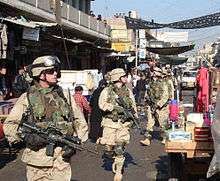
In March 2003, 1-325, 2–325 and 3-325 Airborne Infantry of the 2nd BCT were attached to the 75th Ranger Regiment as part of a special operations task force to conduct a parachute assault to seize Saddam International Airport in support of Operation Iraqi Freedom. On 21 March 2003, D Company crossed the Saudi Arabia–Iraq border as part of Task Force Hunter to escort heavy rocket artillery indirect fire systems to destroy Iraqi artillery batteries in the western Iraqi desert. Upon cancellation of the parachute assault to seize the airport, the battalions returned to their parent 325th Airborne Infantry Regiment at Talil Airfield near An Nasariyah, Iraq. The 325th AIR then continued operations in Samawah, Fallujah, and Baghdad. The brigade returned to the United States by the end of February 2004.[38]
The early days of the 82nd Airborne's participation in the deployment were chronicled by embedded journalist Karl Zinsmeister in his 2003 book Boots on the Ground: A Month with the 82nd Airborne in the Battle for Iraq.
In April 2003, according to Human Rights Watch, soldiers from a subordinate unit, the 325th Airborne Infantry Regiment, fired indiscriminately into a crowd of Iraqi civilians protesting their presence in the city of Fallujah. They killed and wounded many civilians. The battalion suffered no casualties.[39]
The 3rd brigade deployed to Iraq in the summer, redeploying to the U.S. in Spring 2004. The 1st brigade deployed in January 2004. The last units of the division left by the end of April 2004. The 2nd brigade deployed on 7 December 2004 to support the free elections and returned on Easter Sunday in 2005. During this initial deployment 36 soldiers from the division were killed and about 400 were wounded, out of about 12,000 deployed. On 21 July 2006, the 1/325 along with a platoon from A Battery, 2nd Battalion, 319th Airborne Field Artillery Regiment and a troop from 1st Squadron, 73rd Cavalry Regiment deployed to Tikrit, Iraq returning in December 2006. Just days after returning home, the battalion join the rest of the 2nd Brigade in another deployment scheduled for the beginning of January 2007.
Rapid deployment operations
Afghanistan
In late September 2004 The National Command Authority alerted TF 1-505th PIR for an emergency deployment to Afghanistan in support of that October's (first free) elections.
Iraq
In December 2004, the task forces based on 2-325th AIR and 3-325th AIR deployed to Iraq to provide a safe and secure environment for the country’s first-ever free national elections. Thanks in part to the efforts of 2nd Brigade paratroopers, more than eight million Iraqis were able to cast their first meaningful ballots.
Operation Enduring Freedom VI, 2005–06
The First Brigade of the 82nd deployed in April 2005 in support of OEF 6, and returned in April 2006.
Hurricane Katrina
The 82nd Airborne's 3rd Brigade, 505th Parachute Infantry Regiment and the division's 319th Airborne Field Artillery Regiment along with supporting units deployed to support search-and-rescue and security operations in New Orleans, Louisiana after the city was flooded by Hurricane Katrina in September 2005. About 5,000 paratroopers commanded by Major General William B. Caldwell IV, operated out of New Orleans International Airport.
Reorganization
In January 2006, the division began reorganizing from a division based organization to a brigade combat team based organization. Activated elements include a 4th Brigade Combat Team (1–508th INF, 2–508th INF, 4–73rd Cav (RSTA), 2–321st FA, 782nd BSB, and STB, 4th BCT) and the inactivation of the Division Artillery, 82nd Signal Battalion, 307th Engineer Battalion, and 313th Military Intelligence Battalion. The 82nd Division Support Command (DISCOM) was redesignated as the 82nd Sustainment Brigade. A pathfinder unit was reactivated within the 82nd when the Long Range Surveillance Detachment of the inactivating 313th Military Intelligence Battalion was transferred to the 2nd Battalion, 82nd Aviation Regiment and converted to a pathfinder role.
Operation Iraqi Freedom, 2006–09, "The Surge"
On 4 January 2007, 2nd BCT deployed once again to Iraq in support of OIF. On 4 June 2007, 1st Brigade deployed to Southern Iraq, returning 15 July 2008. Since the deployment began, the division has lost 37 paratroopers. Since 11 September 2001, the division has lost 20 paratroopers in Afghanistan and 101 paratroopers in Iraq.

Operation Enduring Freedom, 2007–08
In January 2007, then Maj. Gen. David M. Rodriguez deployed the division headquarters to Bagram, Afghanistan, accompanied by 4th BCT and the Aviation Brigade, as Commander, Combined Joint Task Force-82 (CJTF-82)and Regional Command - East for Operation Enduring Freedom VIII. The 3rd BCT, 10th Mountain Division (Light Infantry) was extended for 120 days to increase the troop strength against the Taliban spring offensive. Extended to 15-month deployment, 4th BCT, which included 1–508th PIR, 2–508th PIR, and 4th Squadron, 73rd Cavalry, was commanded by then Col. Martin P. Schweitzer and remained in Khowst Province from January 2007 until April 2008. The 2–508th PIR worked to establish and maintain firebases in and around the Ghazni province while actively patrolling their operational area. The 1-508 served in Regional Command-South. Working mostly out of Kandahar province as the theater tactical force, they mentored the Afghan National Security Force, conducted combined operations with both ANSF and NATO partners in the Helmand province.[40] Supporting the division were the 36th Engineer Brigade, and the 43rd Area Support Group.
Operations Enduring Freedom, Iraqi Freedom and New Dawn, 2008–11
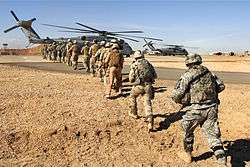
In December 2008, the 3rd BCT deployed to Baghdad, Iraq and redeployed to Ft. Bragg In November 2009. In August 2009, 1st BCT deployed once again to Iraq and redeployed late July 2010.
During the months of August and September 2009, 4th BCT deployed again to Afghanistan and returned in August 2010 having lost 38 soldiers.
2nd Brigade deployed to the Anbar Province in Iraq in May 2011 for the last time in support of Operation New Dawn with the mission to advise, train and assist the Iraqi Security Forces and lead the responsible withdrawal of U.S. Forces from Iraq. They were part of the long convoy of equipment and troops who exited Iraq into Kuwait as OIF came to an end.[41]
2010 Haiti earthquake - Operation Unified Response
As part of Operation Unified Response, 2BCT, on rotation as the division's Global Response Force, was alerted and deployed forces to Haiti later that same day for the mission to provide humanitarian assistance following the devastating earthquake in Haiti.[41] Paratroopers distributed water and food during the 2010 Haiti earthquake relief.[42]
Just two months following redeployment from Haiti in 2010, elements of 2nd BCT (Red Falcons) deployed to Afghanistan in support of Operation Enduring Freedom to serve as trainers for the Afghan National Security Forces. In October 2011, the Division Headquarters returned to Afghanistan, where they relieved the 10th Mountain Division as the Headquarters of Regional Command-South.
In February 2012, 4th BCT deployed to Kandahar province. Taliban commander Mullah Dadullah, formed an overwhelming force in Kandahar. Zhari district in southern Kandahar, is where Dadullah was recruiting a high number of jihadist. 4th BCT of the 82nd held the 5-month siege from March 2012 to the end of July, witnessing some of the most intense combat since the initial deployments since 2001, 4th BCT inflicted massive casualties among the Taliban. Performing with an almost perfect strategic plan, 4th BCT drove Dadullah and his men out of Kandahar to the Northeastern province of kunar, where Dadullah was killed by air strikes.
As of April 2012, the 1st BCT was deployed to Afghanistan, operating in Ghazni Province, Regional Command-East. The paratroopers took control of Ghazni from the Polish Armed Forces, allowing the Polish Task Force White Eagle (pl:Polski Kontyngent Wojskowy w Afganistanie) to consolidate around the provincial seat in northern Ghazni.[43]
In December 2013, elements of the 4th Brigade deployed again to Afghanistan and they were joined by the 1st Brigade in Spring 2014.[44] Since 11 September 2001, the division has lost 106 paratroopers in Afghanistan and 139 paratroopers in Iraq
Operation Inherent Resolve
On November 3, 2016, it was reported that 1,700 soldiers from the 2nd Brigade Combat Team will deploy to the U.S. Central Command area of responsibility in Iraq, to take part in Operation Inherent Resolve. They will replace the 2nd Brigade Combat Team, 101st Airborne Division and will advise and assist Iraqi Security Forces currently trying to retake Mosul from ISIS fighters.[45]
Current structure
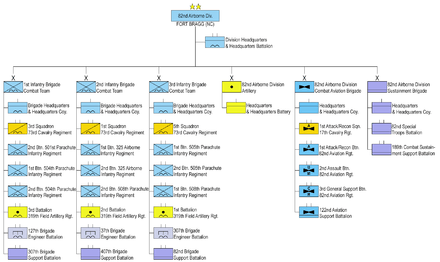
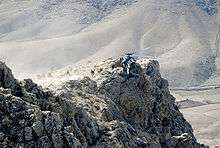
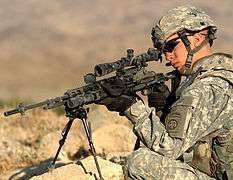
82nd Airborne Division units:[46][47]
 Division Headquarters and Headquarters Battalion, 82d Airborne Division
Division Headquarters and Headquarters Battalion, 82d Airborne Division
- Headquarters and Headquarters Company (HHC)
- Operations Company (Co A)
- Intelligence and Sustainment Company (Co B)
- Division Signal Company (Co C)
- 82d Airborne Division Band
- US Army Advanced Airborne School
 1st Infantry Brigade Combat Team
1st Infantry Brigade Combat Team
- Brigade Headquarters and Headquarters Company
 3rd Squadron, 73rd Cavalry Regiment
3rd Squadron, 73rd Cavalry Regiment 1st Battalion, 504th Infantry Regiment
1st Battalion, 504th Infantry Regiment 2nd Battalion, 504th Infantry Regiment
2nd Battalion, 504th Infantry Regiment- 2nd Battalion, 501st Infantry Regiment
- 3rd Battalion, 319th Field Artillery Regiment
- 127th Brigade Engineer Battalion
- 307th Brigade Support Battalion
 2nd Infantry Brigade Combat Team "Falcon Brigade"[48]
2nd Infantry Brigade Combat Team "Falcon Brigade"[48]
- Brigade Headquarters and Headquarters Company
 1st Squadron, 73rd Cavalry Regiment
1st Squadron, 73rd Cavalry Regiment- 1st Battalion, 325th Infantry Regiment
- 2nd Battalion, 325th Infantry Regiment
- 2nd Battalion, 508th Infantry regiment
- 2nd Battalion, 319th Field Artillery Regiment
- 37th Brigade Engineer Battalion
- 407th Brigade Support Battalion
 3rd Infantry Brigade Combat Team
3rd Infantry Brigade Combat Team
- Brigade Headquarters and Headquarters Company
 5th Squadron, 73rd Cavalry Regiment
5th Squadron, 73rd Cavalry Regiment- 1st Battalion, 505th Infantry Regiment
- 2nd Battalion, 505th Infantry Regiment
- 1st Battalion, 508th Infantry Regiment
- 1st Battalion, 319th Field Artillery Regiment
- 307th Brigade Engineer Battalion
- 82nd Brigade Support Battalion
 82nd Airborne Division Artillery has training and readiness oversight of field artillery battalions, which remain organic to the brigade combat teams.
82nd Airborne Division Artillery has training and readiness oversight of field artillery battalions, which remain organic to the brigade combat teams.
- Headquarters and Headquarters Battery
 82nd Combat Aviation Brigade
82nd Combat Aviation Brigade
- Headquarters and Headquarters Company
 1st Squadron, 17th Cavalry Regiment (Reconnaissance) OH-58D Kiowa Warrior
1st Squadron, 17th Cavalry Regiment (Reconnaissance) OH-58D Kiowa Warrior- 1st Battalion, 82nd Aviation Regiment (Attack) AH-64D Apache Longbow
- 2nd Battalion, 82nd Aviation Regiment (Assault) UH-60M Black Hawk
- 3rd Battalion, 82nd Aviation Regiment (General Support)
- 122nd Aviation Support Battalion
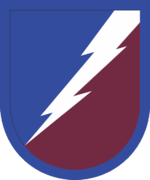 82nd Airborne Division Sustainment Brigade[49]
82nd Airborne Division Sustainment Brigade[49]
- 82nd Special Troops Battalion
- 189th Combat Sustainment Support Battalion
The division's 4th Brigade Combat Team inactivated in fall of 2013: the Special Troops Battalion, 4th BCT;[50] the 2nd Battalion, 321st Field Artillery Regiment; and the 782d Brigade Support Battalion were inactivated with some of the companies of the 782d used to augment support battalions in the remaining three brigades. The 4th Squadron, 73d Cavalry joined the 1st Brigade Combat Team and formed the core of the newly activated 2nd Battalion, 501st Infantry Regiment. The 2d Battalion, 508th Infantry Regiment joined the 2d Brigade Combat Team, while the 1st Battalion, 508th Infantry Regiment joined the 3rd Brigade Combat Team.
Traditions
To commemorate the 1944 Waal assault river crossing made by the 504th Parachute Infantry Regiment and the 307th Engineer Battalion (Airborne) during Operation Market Garden, an annual Crossing of the Waal competition is staged on the anniversary of the operation at McKellars Lake near Fort Bragg. The winning company receives a paddle.[51] The paddle signifies that in the original crossing, many paratroopers had to row with their weapons because the canvas boats lacked sufficient paddles.
Honors
Campaign participation credit

- World War I
- St. Mihiel
- Meuse-Argonne
- Lorraine 1918
- World War II
- Sicily
- Naples-Foggia
- Normandy (with arrowhead)
- Rhineland (with arrowhead)
- Ardennes-Alsace
- Central Europe
- Armed Forces Expeditions
- Dominican Republic
- Grenada
- Panama
- Southwest Asia
- Defense of Saudi Arabia
- Liberation and Defense of Kuwait

- Operation Enduring Freedom
- Operation Iraqi Freedom
Medal of Honor recipients
World War I
- Lt. Col. Pike, Emory, J.
- Corp. York, Alvin, C.
World War II
- Pvt. Towle, John, R.
- Pfc. Deglopper, Charles, N.
- 1st Sgt. Funk, Leonard, A. Jr.
- Pvt. Gandara, Joe[52]
Vietnam War
- SSG Conde-Falcon, Felix, M.[52]
Decorations
- Presidential Unit Citation (Army) for Sainte-Mère-Église.
- Presidential Unit Citation (Army) for Operation Market Garden.
- Presidential Unit Citation (Army) for Chiunzi Pass/Naples/Foggia awarded to the following units of the 82nd Airborne: 319th Glider Field Arty Bn,307th Engineer Bn (2nd), 80th Anti-aircraft Bn and Company H, 504 PIR
- Valorous Unit Citation (Army) for Operation Iraqi Freedom (3rd Brigade Combat Team, OIF 1)
- Meritorious Unit Commendation (Army) for SouthWest Asia.
- French Croix de Guerre with Palm, World War II for Sainte-Mère-Église.
- French Croix de Guerre with Palm, World War II for Cotentin.
- French Croix de Guerre, World War II, Fourragère
- Belgian Fourragere 1940
- Cited in the Order of the Day of the Belgian Army for action in the Ardennes
- Cited in the Order of the Day of the Belgian Army for action in Belgium And Germany.
- Military William Order, for bravery and valiant service in battle at Nijmegen 1944 during Market Garden (worn as an Orange Lanyard) 8 October 1945.[53]
- Presidential Unit Citation (Army) for the Battle of Samawah, April 2003, awarded to the following unit of the 82nd Airborne: 2nd Brigade Combat Team (325th Airborne Infantry Regiment)
- Presidential Unit Citation (Army) for Operation Turkey Bowl, OIF, November 2007, awarded to the following unit of the 82nd Airborne: 5th Squadron, 73rd Cavalry, 3rd Brigade, 505th PIR
- Valorous Unit Citation (Army) for actions on objective in the Baghdad neighborhood of Ghazaliya. While attached to 3rd Brigade, 1st Armored Division. Cited in Department of the Army General Order 2009–10
- Superior Unit Award (Army) US Army Garrison, Ft Bragg 11 September 2001 – 15 April 2006 Cited in DAGO 2009–29
Units during WW II
The following are 82nd Airborne units during World War II.[54]
- Division Headquarters
- 325th Glider Infantry Regiment
- 504th Parachute Infantry Regiment (assigned 15 August 1942; replaced 327th Inf Rgt relieved that same date)
- 505th Parachute Infantry Regiment (assigned 10 February 1943; replaced 326th Inf Rgt which departed on 4 February 1943)
- 507th Parachute Infantry Regiment (attached 14 January 1944 – 1 March 1945)
- 508th Parachute Infantry Regiment (attached 14 January 1944 – 21 January 1945; 23 January 1945 through 9 May 1945)
- 517th Parachute Infantry Regiment (attached 1–11 January 1945; 23–26 January 1945; 3–5 February 1945; 9–10 February 1945)
- 1st Battalion, 551st Parachute Infantry Regiment (attached 26 December 1944 – 13 January 1945; 21–27 January 1945)
- HHB, Division Artillery
- 319th Glider Field Artillery Battalion (75mm Normandy, Netherlands, Germany/105mm Italy)
- 320th Glider Field Artillery Battalion (75mm Italy/105mm Normandy, Netherlands, Germany)
- 376th Parachute Field Artillery Battalion (75mm)
- 456th Parachute Field Artillery Battalion (75mm)
- 80th Airborne Antiaircraft Battalion
- 307th Airborne Engineer Battalion
- 307th Airborne Medical Company
- 82nd Parachute Maintenance Company
- 82nd Counter Intelligence Corps Detachment
- Headquarters, Special Troops
- Headquarters Company, 82nd Airborne Division
- 782nd Airborne Ordnance Maintenance Company
- 407th Airborne Quartermaster Company
- 82nd Airborne Signal Company
- Military Police Platoon
- Reconnaissance Platoon (assigned in 1 March 1945 reorganization)
- Band (assigned in 1 March 1945 reorganization)
- Honor Guard Platoon (post-war) provided honor guards at the Kleist Palace, Berlin and other locations. Capt. Howard A. Stephens commanding
See also
- List of commanders of 82nd Airborne Division (United States)
- 82nd Airborne Division War Memorial Museum
- British Parachute Regiment
- Maroon beret
- Geneviève Duboscq
- Medal of Honor: Airborne
- Monica Lin Brown
- World War II combat jump airfields:
Notes
- ↑ "Reconfigure Army divisions to make military stronger".
- 1 2 "Lineage and Honors Information: 82nd Airborne Division". United States Army Center of Military History. Retrieved 22 December 2009.
- 1 2 3 4 5 6 7 8 "82nd Airborne Division History". GlobalSecurity. Retrieved 22 December 2009.
- ↑ Rutledge, G.K,, The Atlanta Georgian, "Name for 82nd Division to be Chosen by next Sunday Tuesday April 2, 1918 page 1.
- ↑ McGrath, John J. (2004). The Brigade: A History: Its Organization and Employment in the US Army. Combat Studies Institute Press. p. 172. ISBN 978-1-4404-4915-4.
- ↑ "82nd Division Composition (World War I)". United States Army Center of Military History. Retrieved 22 December 2009.
- 1 2 3 4 5 6 7 8 9 10 11 "82nd Division Record of Events (World War I)". United States Army Center of Military History. Retrieved 22 December 2009.
- ↑ Verier, Mike (2001). 82nd Airborne Division 'All American'. London: Ian Allan. p. 8.
- ↑ Army Almanac: A Book of Facts Concerning the Army of the United States. United States Government Printing Office. 1959. p. 587.
- 1 2 "82nd Airborne Division History". 82nd Airborne Division Public Affairs Office. Archived from the original on 25 December 2009. Retrieved 1 September 2012.
- ↑ Blair, Clay (1985). Ridgeway's Paratroopers The American Airborne in World War II. Naval Institute Press. pp. Plate 11.
- ↑ Doyle, Charles H.; Terrell Stewart (1988). Stand in the Door!. Williamstown, New Jersey: Phillips Publications. p. 104.
- ↑ Ambrose, S. E. (2002). D-Day. Pocket Books. p. 24.
- ↑ Ruggero, Ed (29 May 2007). The First Men In: US Paratroopers and the Fight to Save D-Day. Harper Collins. p. 307. ISBN 978-0-06-073129-8. Retrieved 31 October 2012.
- ↑ Megellas, James (2007). All the Way to Berlin: A Paratrooper at War in Europe. Random House Publishing Group. p. 165. ISBN 0-307-41448-5.
- ↑ “Four Stars of Valor: The Combat history of the 505th Parachute Infantry Regiment in World War II” Nordyke, P., 2006 p. 329 - 331.
- ↑ Timothy J. “The Ardennes on Fire: The First Day of the German Assault” 2010 pp. 56-58.
- ↑ Gavin, J. “On To Berlin: Battles of an Airborne Commander 1943- 1946”, 1978 p. 239.
- ↑ Nordyke, P., “All American All the Way: The Combat History of the 82nd Airborne Division in World War II” 2005, p. 655
- ↑ LoFaro G., “The Sword of St. Michael: The 82nd Airborne Division in World War II” 2011, p. 481
- ↑ Gavin, J. “On To Berlin: Battles of an Airborne Commander 1943- 1946”, 1978 p. 249.
- ↑ “The Last Battle” published in the Journal “Army” April 2001 pp. 38-39
- ↑ 82nd Airborne After Action Report
- ↑ Ellis, John (1990). Brute force: allied strategy and tactics in the Second World War. Deutsch. p. 440. ISBN 978-0-233-97958-8. Retrieved 12 September 2012.
- ↑ Reynolds, David (1 September 1998). Paras: An Illustrated History of Britain's Airborne Forces. Sutton. p. 220. ISBN 978-0-7509-1723-0. Retrieved 12 September 2012.
- 1 2 3 4 5 Army Battle Casualties and Nonbattle Deaths in World War II, Final Report (Statistical and Accounting Branch Office of the Adjutant General, 1 June 1953)
- 1 2 Steven J. Mrozek (1997). 82nd Airborne Division. Turner Pub. Co. p. 65. OCLC 52963023.
- ↑ "3d Battalion, 320th Field Artillery". History.army.mil. Retrieved 6 February 2014.
- ↑ Vietnam Order of Battle, by Captain (Ret.) Shelby L. Stanton, p. 83
- ↑ Pike, John. "3rd Brigade Combat Team, 82nd Airborne Division". Globalsecurity.org. Retrieved 13 June 2012.
- ↑ "1971 May Day Protests at AllExperts". Associatepublisher.com. 3 May 1971. Retrieved 13 June 2012.
- ↑ SFC Robert Patty, retired
- ↑ John Pike. "2nd Battalion, 325th Airborne Infantry Regiment". Globalsecurity.org. Retrieved 6 February 2014.
- ↑ Mann, Jim (23 August 1990). "NEWS ANALYSIS: Bush's 'Line in the Sand' Shifts as Objectives Grow: Strategy: The initial mission was to defend Saudi Arabia. Now troops could be used to free hostages, liberate Kuwait, topple Hussein". Los Angeles Times. Retrieved 6 February 2014.
- ↑ Ulbrich, Jeffrey. "82nd Airborne savors 'helping our own'". news.google.com. Gainesville Sun. Retrieved 16 August 2015.
- ↑ "82nd Airborne Division". bragg.army.mil. Retrieved 27 July 2015.
- ↑ Gillert, Douglas. "After Jumping, Battalion Learns to Crawl". archive.defense.gov. US Department of Defense. Retrieved 29 December 2015.
- ↑ Pike, John. "2nd Battalion, 325th Airborne Infantry Regiment". Globalsecurity.org. Retrieved 13 June 2012.
- ↑ Iraq: U.S. Should Investigate al-Falluja (Report). Human Rights Watch. 17 June 2003. Retrieved 1 September 2013.
- ↑ "Transcript: DoD News Briefing with Col. Schweitzer from Afghanistan". Defense.gov. Archived from the original on 9 January 2014. Retrieved 6 February 2014.
- 1 2 "DVIDS - News - Falcons say farewell to brigade commander". Dvidshub.net. 6 March 2013. Retrieved 6 February 2014.
- ↑ de Montesquiou, Alfred; and Mike Melia (16 January 2010). "Haiti earthquake survivors get more food and water". The San Diego Union-Tribune. Associated Press. Retrieved 1 September 2012.
- ↑ "Contact Support". Rc-east.com. Retrieved 6 February 2014.
- ↑
- ↑ "Army to Deploy 1,700 Paratroopers to Iraq". military.com. 3 November 2016.
- ↑ "Fort Bragg". Bragg.army.mil. 16 July 2013. Retrieved 6 February 2014.
- ↑ Brooks, Drew (22 January 2014). "82nd Airborne Division's 4th Brigade Combat Team headed to Afghanistan". Fayetteville Observer. Retrieved 6 February 2014.
- ↑ Falcon Brigade: ready to fight, training to win accessdate=201608-17
- ↑ "Fort Bragg".
- ↑ "Coat of Arms". Tioh.hqda.pentagon.mil. 2006-08-01. Retrieved 2014-07-21.
- ↑ Wilt, Susan (22 September 2008). "82nd Airborne engineers re-enact famous WWII river crossing". U.S. Army. Retrieved 30 October 2012.
- 1 2 "Recipients - Valor 24 - Medal of Honor". The United States Army. Retrieved 11 January 2015.
- ↑ (Dutch)Databank dapperheidsonderscheidingen, Militaire Willems-Orde: Vaandel der 82nd U.S. Airborne Division, niveau MWO 4. Retrieved 10 mei 2016.
- ↑ "82d Airborne Division". Order of Battle of the United States Army World War II. United States Army. December 1945. Archived from the original on 11 March 2008. Retrieved 16 March 2008.
Additional reading
- Alexander, Mark, and John Sparry. Jump Commander: In Combat with the 82nd Airborne in World War II. Philadelphia : Casemate, 2010. ISBN 1-935149-28-8 OCLC 506253036
- Angress, Werner T. Witness to the Storm: A Jewish Journey from Nazi Berlin to the 82nd Airborne, 1920–1945. Durham, NC :Miriam Angress, 2012. ISBN 1-4774-5701-1 OCLC 804824030
- Anzuoni, Robert P. I'm the 82nd Airborne Division!: A History of the All American Division in World War II After Action Reports. Atglen, PA : Schiffer Military History, 2005. ISBN 0-7643-2347-4 OCLC 62555533
- Anzuoni, Robert P. The All American: An Illustrated History of the 82nd Airborne Division, 1917 to the Present. Atglen, PA: Schiffer Pub, 2001. ISBN 0-7643-1321-5 OCLC 49935879
- Barry, Robert F. Power Pack: Dominican Republic, 1965–1966. Portsmouth, Va: Messenger, 1965. OCLC 6655474
- Baugh, James Emory. From Skies of Blue: My Experiences with the Eighty-Second Airborne During World War II. New York : iUniverse, 2003. ISBN 0-595-74982-8 OCLC 64584040
- Breuer, William B. Drop Zone, Sicily: Allied Airborne Strike, July 1943. Novato, CA: Presidio, 1983. ISBN 0-89141-196-8 OCLC 9945654
- Burriss, T. Moffatt. Strike and Hold: A Memoir of the 82nd Airborne in World War II. Washington, D.C.: Brassey's, 2000. ISBN 1-57488-258-9 OCLC 43903491
- Caraccilo, Dominic J. The Ready Brigade of the 82nd Airborne in Desert Storm: A Combat Memoir by the Headquarters Company Commander. Jefferson, N.C.: McFarland, 1993. ISBN 0-89950-829-4 OCLC 27265069
- Carter, Ross S. Those Devils in Baggy Pants. Cutchogue, NY : Buccaneer Books, 1996. ISBN 0-89966-613-2 OCLC 68043161
- Cooke, James J. The All-Americans at War: The 82nd Division in the Great War, 1917–1918. Westport, Conn: Praeger, 1999. ISBN 0-275-95740-3 OCLC 39210048
- Cooksey, Jon. Crossing the Waal: The U.S. 82nd Airborne Division at Nijmegen. Barnsley: Pen and Sword Military, 2005. ISBN 1-84415-228-6 OCLC 57200754
- Covington, Henry L. A Fighting Heart, An Unofficial Story of the 82nd Airborne Division. Fayetteville, NC: T. Davis, 1949. OCLC 4139070
- Dawson, Buck. Saga of the All American. Atlanta: Albert Love Enterprises, 1946. OCLC 3595988
- Francois, Dominique. 82nd Airborne Division 1917–2005. Bayeux: Heimdal, 2006. ISBN 2-84048-215-0 OCLC 64967339
- Gavin, James M. On to Berlin: Battles of an Airborne Commander, 1943–1946. New York: Viking Press, 1978. ISBN 0-670-52517-0 OCLC 3204743
- Grey, Stephen. Into the Viper's Nest: The First Pivotal Battle of the Afghan War. Minneapolis: Zenith Press, 2010. ISBN 0-7603-3897-3 OCLC 548583278
- Heilman, William H. A Pilot's Tale: Flying Helicopters in Vietnam. Hooks, Tex.?: William H. Heilman,], 2008. ISBN 1-4357-1185-8 OCLC 671642623
- Hoyt, Edwin Palmer. The Invasion Before Normandy: The Secret Battle of Slapton Sands. Lanham, MD : Scarborough House, 1999. ISBN 0-8128-8562-7 OCLC 41712914
- Imai, Kesaharu. Grenada : October 25 to November 2, 1983. Tokyo : World Photo Press, 1984. OCLC 16348601
- Langdon, Allen. Ready: The History of the 505th Parachute Infantry Regiment, 82nd Airborne Division, World War II. [Fort Bragg, N.C.]: The Division, 1986. OCLC 16221387
- Lebenson, Leonard. Surrounded by Heroes: Six Campaigns with Division Headquarters, 82nd Airborne Division, 1942–1945.Drexel Hill, PA: Casemate, 2007. ISBN 1-932033-58-0 OCLC 124985055
- LoFaro, Guy Sword of St. Michael: The 82nd Airborne Division in World War II. Cambridge, MA: Da Capo Press, 2011. ISBN 0-306-82023-4 OCLC 659768768
- Lunteren, Frank van. The Battle of the Bridges: The 504th Parachute Infantry Regiment in Operation Market Garden. Philadelphia: Casemate Publishing, 2014. ISBN 978-1-61200-232-3
- Lunteren, Frank van. Blocking Kampfgruppe Peiper: The 504th Parachute Infantry Regiment in the Batlle of the Bulge. Philadelphia: Casemate Publishing, 2015.
- Lunteren, Frank van. Spearhead of the Fifth Army: The 504th Parachute Infantry Regiment in Italy, from the Winter Line to Anzio. Philadelphia, Casemate Publishing, 2016.
- Marshall, S. L. A., Carl Sandburg, and H. Garver Miller. Night Drop: The American Airborne Invasion of Normandy. Boston: Little, Brown, 1962. OCLC 1260577
- McCann, John P. Passing Through : The 82nd Airborne Division in Northern Ireland 1943–44. Newtownards, County Down, Northern Ireland : Colourpoint Books, 2005. ISBN 1-904242-41-3 OCLC 60883703
- McKenzie, John D. On Time, on Target: The World War II Memoir of a Paratrooper in the 82nd Airborne. Novato, CA: Presidio Press, 2000. ISBN 0-89141-714-1 OCLC 42863044
- McManus, John C. September Hope: The American Side of a Bridge Too Far. New York: New American Library, 2012. ISBN 0-451-23706-4 OCLC 741538553
- Megellas, James. All the Way to Berlin: A Paratrooper at War in Europe. New York: Ballantine Books, 2003. ISBN 0-89141-784-2 OCLC 50810144
- Mrozek, Steven J. 82nd Airborne Division. Paducah, Ky: Turner Pub. Co, 1997. ISBN 1-56311-364-3 OCLC 52963023
- Nordyke, Phil. All American, All the Way: The Combat History of the 82nd Airborne Division in World War II. St. Paul, MN: Zenith Press, 2005. ISBN 0-7603-2201-5 OCLC 60757547
- Nordyke, Phil. The All Americans in World War II: A Photographic History of the 82nd Airborne Division at War. St. Paul, MN: Zenith Press, 2006. ISBN 0-7603-2617-7 OCLC 64961665
- Ruggero, Ed. Combat Jump: The Young Men Who Led the Assault into Fortress Europe, July 1943. New York : HarperCollins, 2003. ISBN 0-06-008875-3 OCLC 51978036
- Saunders, Tim. Nijmegen, Grave, and Groesbeek. Barnsley, South Yorkshire: Leo Cooper, 2001. ISBN 0-85052-815-1 OCLC 49594764
- Thompson, Leroy. The All Americans: The 82nd Airborne. Newton Abbot, Devon: David & Charles Publishers, 1988. ISBN 0-7153-9182-8 OCLC 19393819
- Zinsmeister, Karl. Boots on the Ground: A Month with the 82nd Airborne in the Battle for Iraq. New York: Truman Talley Books/St. Martin's Press, 2003. ISBN 0-312-32663-7 OCLC 52775207
- Zinsmeister, Karl, Dan Jurgens, and Raul Trevino. Combat Zone: True Tales of GIs in Iraq. New York, NY: Marvel Comics, 2005. ISBN 0-7851-1516-1 OCLC 61373604
External links
| Wikimedia Commons has media related to 82nd Airborne Division. |
- Fort Bragg Homepage
- Historical Account of the 82nd Airborne Division
- All American: The Story of the 82nd Airborne Division – World War II unit history booklet, 1945
- 82nd Airborne Combat Footage DVD World War II Normandy June 1944
- 82nd AB Combat Footage DVD World War II including Operation Market Garden September 1944
- The 82nd Airborne Division
- THE 82ND AIRBORNE DIVISION
- The 82nd Airborne during World War II
- 82nd Airborne Division, NYC Victory Parade, 12 Jan 1946
- The short film Big Picture: Arctic Night is available for free download at the Internet Archive
- The short film Big Picture: All American is available for free download at the Internet Archive
- The short film Big Picture: This is Our Strength is available for free download at the Internet Archive
- The short film STAFF FILM REPORT 66-17A (1966) is available for free download at the Internet Archive
- The short film STAFF FILM REPORT 66-18A (1966) is available for free download at the Internet Archive
- The short film STAFF FILM REPORT 66-19A (1966) is available for free download at the Internet Archive
- The short film STAFF FILM REPORT 66-20A (1966) is available for free download at the Internet Archive
- The short film STAFF FILM REPORT 66-25A (1966) is available for free download at the Internet Archive
- The short film STAFF FILM REPORT 66-27A (1966) is available for free download at the Internet Archive
- The short film STAFF FILM REPORT 66-28A (1966) is available for free download at the Internet Archive
- "Droppingzones (GPS) on D-day 101st and 82nd Airborne Division"
- http://articles.baltimoresun.com/2002-02-15/news/0202150101_1_tactical-mobility-airborne-division-heavy-divisions
- ↑ Rutledge, G.K,, The Atlanta Georgian, "Name for 82nd Division to be Chosen by next Sunday Tuesday April 2, 1918 page 1
